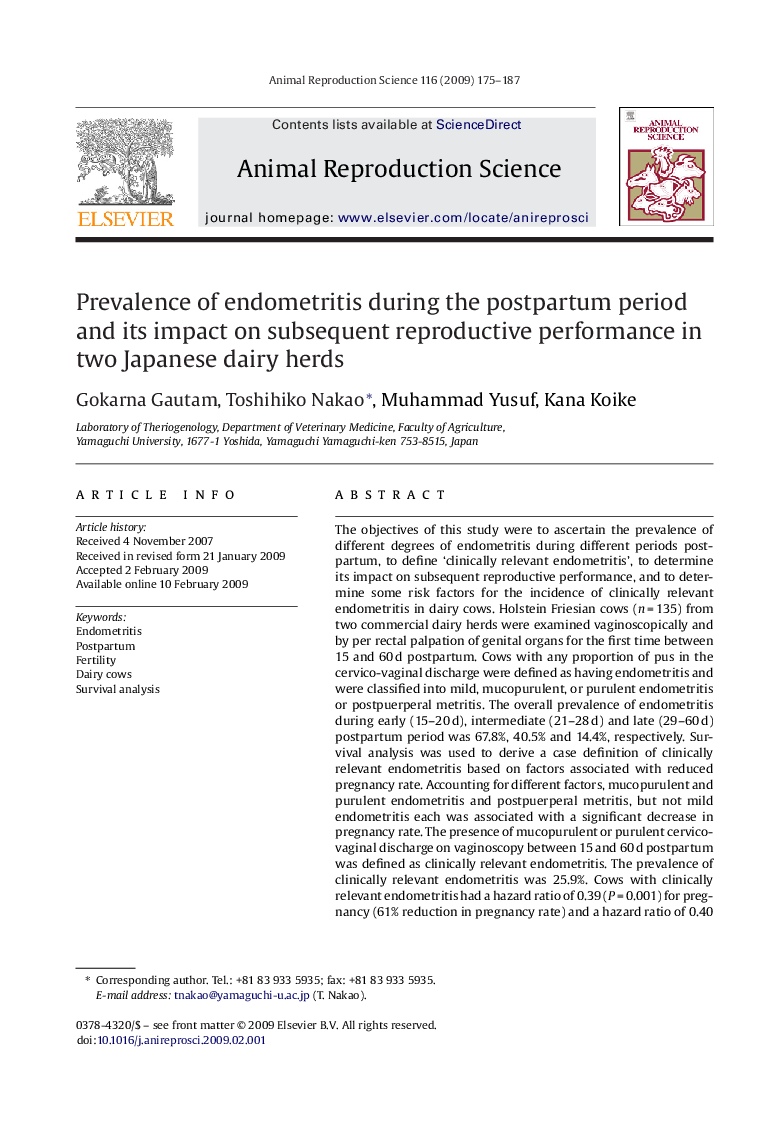| کد مقاله | کد نشریه | سال انتشار | مقاله انگلیسی | نسخه تمام متن |
|---|---|---|---|---|
| 2073914 | 1544789 | 2009 | 13 صفحه PDF | دانلود رایگان |

The objectives of this study were to ascertain the prevalence of different degrees of endometritis during different periods postpartum, to define ‘clinically relevant endometritis’, to determine its impact on subsequent reproductive performance, and to determine some risk factors for the incidence of clinically relevant endometritis in dairy cows. Holstein Friesian cows (n = 135) from two commercial dairy herds were examined vaginoscopically and by per rectal palpation of genital organs for the first time between 15 and 60 d postpartum. Cows with any proportion of pus in the cervico-vaginal discharge were defined as having endometritis and were classified into mild, mucopurulent, or purulent endometritis or postpuerperal metritis. The overall prevalence of endometritis during early (15–20 d), intermediate (21–28 d) and late (29–60 d) postpartum period was 67.8%, 40.5% and 14.4%, respectively. Survival analysis was used to derive a case definition of clinically relevant endometritis based on factors associated with reduced pregnancy rate. Accounting for different factors, mucopurulent and purulent endometritis and postpuerperal metritis, but not mild endometritis each was associated with a significant decrease in pregnancy rate. The presence of mucopurulent or purulent cervico-vaginal discharge on vaginoscopy between 15 and 60 d postpartum was defined as clinically relevant endometritis. The prevalence of clinically relevant endometritis was 25.9%. Cows with clinically relevant endometritis had a hazard ratio of 0.39 (P = 0.001) for pregnancy (61% reduction in pregnancy rate) and a hazard ratio of 0.40 (P = 0.001) for pregnancy per insemination. Cows with clinically relevant endometritis had more days open (325 vs. 120; P < 0.001) and required more inseminations for 50% cows to become pregnant (5 vs. 2; P < 0.001) than those without clinically relevant endometritis. Clinically relevant endometritis diagnosed between 15 and 20 d postpartum was also associated with reduced pregnancy rate (HR = 0.34; P = 0.05). Based on logistic regression analysis, herd (P = 0.002), higher parities (P = 0.04), retention of fetal membranes (odds ratio, OR = 4.24; P = 0.05), early postpartum complications (OR = 15.2; P = 0.001) and earlier postpartum period at examination (P < 0.001) significantly increased the risk of diagnosing clinically relevant endometritis within 60 d postpartum. In conclusion, 25.9% cows had clinically relevant endometritis within two months postpartum that adversely affected the subsequent fertility in two Japanese dairy herds.
Journal: Animal Reproduction Science - Volume 116, Issues 3–4, December 2009, Pages 175–187